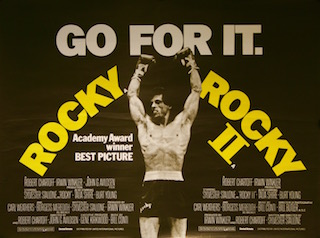
A portrait of legendary Hollywood cinematographer and former Iowan Bill Butler captured in January 1977 by Butler’s daughter, Pamela Butler Fraser. She took the photograph of her father during the filming of 1978’s “Capricorn One,” in which she served as a camera assistant. Photo courtesy of Pamela Butler Fraser
By Michael Swanger
Picture this: The next time you get goose bumps after being lured again by “Jaws,” or feel the adrenaline pumping through your veins during the training scenes of “Rocky” sequels, or your heart skips a beat like a teenager head-over-heels in love while watching “Grease,” you are looking through the lens of legendary cinematographer and former Iowan, Bill Butler.
Renowned as one of the most creative, innovative and versatile directors of photography, the 100-year-old Butler’s list of film and television credits is as expansive as the variety of instinctive behaviors they have elicited for generations of movie-goers and television viewers. He is among a handful of revered, risk-taking directors of photography including Haskell Wexler, Owen Roizman, Conrad Hall and Vilmos Zsigmond who forever changed the way Hollywood movies were shot and lit starting in the 1960s.
During the last six decades Butler has filmed more than 100 movies around the world, eight of which grossed more than $100 million. Along the way, he has worked with iconic Hollywood directors such as Steven Spielberg, Francis Ford Coppola, Mike Nichols and Sylvester Stallone. His film credits include “The Rain People” (1969), “Deliverance” (1972), “The Godfather” (1973), “The Conversation” (1974), “Jaws” (1975), “One Flew Over the Cuckoo’s Nest” (1975), “Grease” (1978), “Rocky II” (1979), “Stripes” (1981), “Rocky III” (1982), “Rocky IV” (1985), “Biloxi Blues” (1988), “Graffiti Bridge” (1990), “Hot Shots!” (1991), “Flipper” (1996), “Anaconda” (1997), “Deceiver” (1997) and “Frailty” (2001).
A former television cameraman and documentarian who first broke all of the artistic rules on the small screen before leaving for Hollywood, some of Butler’s most recognized television credits include “The People vs. Paul Crump” (1962), “A Clear and Present Danger” (1972), “Something Evil” (1972), “Savage” (1972), “The Execution of Private Slovik” (1974), “Raid on Entebbe” (1977), “The Thorn Birds” (1983), “A Streetcar Named Desire” (1984), “Don King: Only in America” (1997) and “Hendrix” (2000).



Though the artistic depth, longevity and commercial success of his work speaks volumes about his career, Butler was nominated for an Academy Award for Best Cinematography and BAFTA Film Award for his work behind the camera on “One Flew Over the Cuckoo’s Nest,” in which he shared the nomination with Wexler, whom he replaced to complete the film. He won two Primetime Emmy Awards for “Raid on Entebbe” and “A Streetcar Named Desire.” In 2003, Butler received the American Society of Cinematographers Lifetime Achievement Award. His groundbreaking work on “Jaws” was acknowledged during the ceremony in a letter from Spielberg.
“You were the calm before, during and after every storm on the set of ‘Jaws,’” Spielberg wrote. “Without your Zen-like confidence and wonderful sense of humor, I would have gone the way of the rest of the ‘Jaws’ crew — totally out of my friggin’ mind. Congratulations on this well-deserved career achievement award from your peers. All my best, Steven.”
“I could never, ever, pick one director, actor or film as my favorite,” Butler told Burlington’s The Hawk Eye when he returned to his hometown of Mount Pleasant in 2014 for a reception to honor his prolific career. “You can’t imagine the ride I’ve had. I’ve been around the world many, many times. And have done many wonderful things in my life. How can I put one above the other? Every one of my experiences have been rewarding and unique in its own way. I can tell you this. It’s been a hell of a lot of fun.”
In a Zoom video interview with Iowa History Journal from his home in Montana a few weeks prior to his 100th birthday, Butler spoke at length about his career and the changes he has witnessed in the mediums in which he has flourished professionally, including the birth of television, atomic energy and the digital age.
TO READ THE ENTIRE STORY AND OTHER FASCINATING STORIES ABOUT IOWA HISTORY, subscribe to Iowa History Journal.
